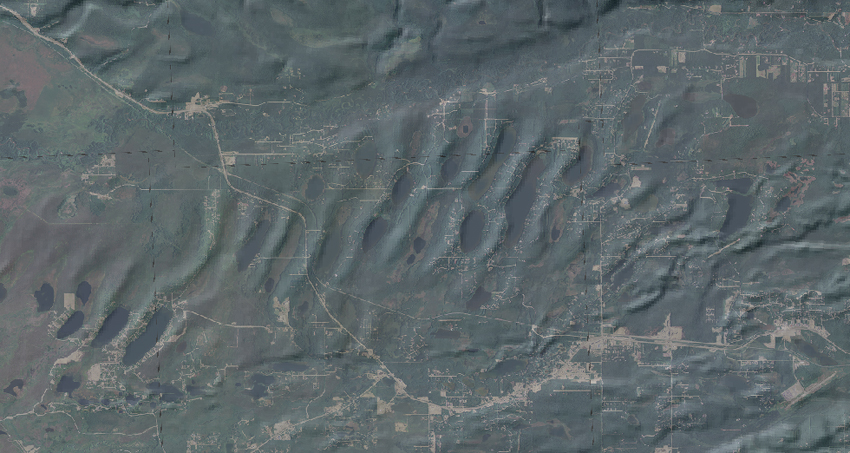
A shaded relief image under 2004 aerial photography showing the very large dune (VLD) features in the Meadow-Beaver Lakes area
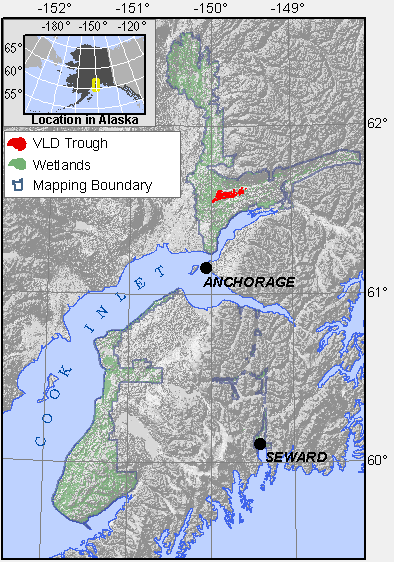
Range map showing the location of the VLD features, in the Matanuska Valley
VLD Trough wetlands (the Very Large Dunes of Weidmer et al 2011) are found only in the N-S trending valleys of the Meadow and Beaver Lakes Area. These uniquely arranged dunes were apparently created by gigantic waves (dunes can be formed by other processes besides wind) formed during a flood following the collapse of an ice dam that catastrophically drained Lake Atna. The 17 prominent VLDs are approximately 5 km long, and 800 meters crest-to-crest. Lake Atna was a 9500-square km lake formed in the Cooper River Basin near the end of the last glacial maximum (Wiedmer, et. al., 2010 but see the opposing view of Reger et al. 2011 and the response from Wiedmer et al. 2011). The VLD features have also been called ribbed moraine, and may have formed sub-glacially perhaps with later modification by sub-glacial flooding. They are currently mapped as Rogen moraine, but are no longer considered to be Rogen.
Many wetlands in VLD Troughs support lakes, the largest of which is 230 acre Seymour Lake. VLD Trough lakes are of relatively uniform depth; all of them are about 20 feet deep. Lakes are defined as areas of standing water greater than 20 acres (and deeper than six feet). Lakes are mapped separately from wetlands.
VLD Trough wetlands are peatlands. They often support a bisecting stream. Because the adjacent glacial sediments are coarse-grained cobbles and gravels which allow rapid groundwater transmission, VLD Trough peatlands are often fens, at least toward the east. They should receive ample shallow groundwater discharge to near the surface. Accordingly, they usually show somewhat higher pH and relatively small seasonal water table fluctuations (Table 1).
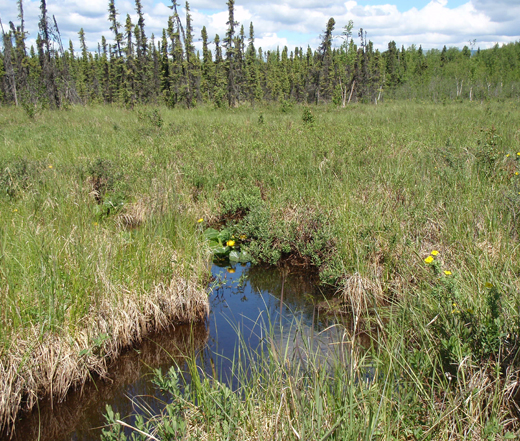
A shrubby VLD Trough wetland with a central stream southeast of Seymour Lake, in the eastern portion of the Meadows Lakes area
Eastward, where precipitation barely exceeds evapotranspiration, fens dominate. Westward, VLD Trough peatlands support bogs atop fen peat. Bogs have lower pH (less than about 4.2) and specific conductance (less than about 50 µS at 25°C) and lack fen indicator plant taxa. In the Matanuska-Susitna Valley, bogs are often forested by black spruce (Picea mariana), with a dense shrubby leatherleaf (Chamaedaphne calyculata) and/or Labrador tea (Ledum palustre ssp. decumbens) understory. Many burned in the 1996 Miller’s Reach Fire.
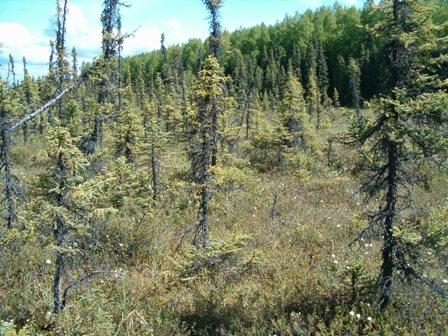
A bog typical of the type found in the western portion of the VLD Trough features (pH= 3.8, SC= 33.0 µS).
NWI and HGM
VLD Trough Wetlands are palustrine wetlands in the US Fish and Wildlife Service’s National Wetlands Inventory classification. They contain a variety of plant dominants from herbaceous emergents (PEM) to shrubs (PSS) and forest (PFO), with hydrologic regimes ranging from saturated through permanently, semi-permanently, and seasonally flooded (PSSB, PEMH, PEMF and PEMC, respectively).
In the LLWW classification of Tiner (2003) they fall into two major types; those along streams are Lotic Stream Slope/Flat throughflow headwater wetlands and wetlands away from streams are mostly Terrene Slope/Flat groundwater-dominated throughflow headwater wetlands.

Box plots of Plant Prevalence Index (PI) in common wetland mapping components. VLD Trough wetlands (highlighted in gray) mapped with lower hydrologic component values (RT2 vs. RT4for example) have lower values for Plant Prevalence Index. Prevalence Index is a good proxy for water table position and variability. Lower values indicate a water table closer to the surface for a longer portion of the growing season. An Index value equal to one indicates that the plot supported only wetland obligate plants (occur in wetlands greater than 99% of the time under natural conditions). A Prevalence Index value greater than 3 suggests that the plot may not be a wetland for jurisdictional purposes. Peatlands in V:LD Troughs generally have lower values for PI indicating a steady supply of ground water flow, which maintains the water level close to the surface.
Prevalence Index is calculated from the percent cover and the wetland indicator status of each plant found in a wetland plot. Lower values indicate a higher prevalence of plants assigned a wetland indicator status of obligate or facultative. Indicator status is assigned nationally, by state, and by regions within states. Prevalence Index may be a better descriptor of the variability of the water table than one-time measurements of the actual position of the water table. Measurements are often made before the water table has fully equilibrated, and are dependent on antecedent conditions. However, if Indicator Status is accurately assigned the plants present will integrate long-term average conditions.
In the box plots, yellow boxes enclose the first through third quartile (where 50% of the data values lie); the gray bar is the median, and the whiskers extend to the last value within 1.5 times the inner quartile range. Values lying beyond 1.5 times the inner quartile range are plotted as hollow circles. The number of samples for each map component is given across the top.
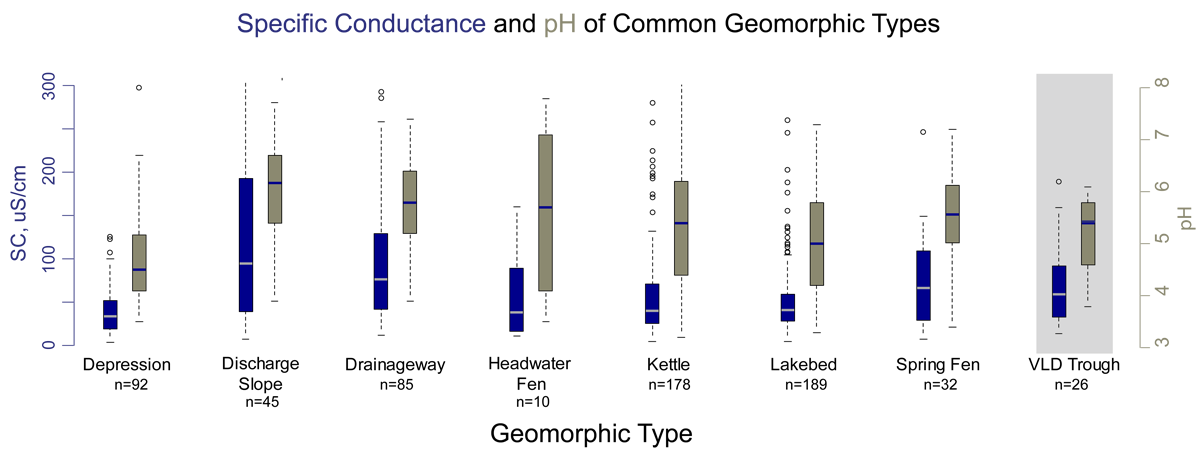
Box plots of specific conductance (SC- blue) and pH (brown) in the common geomorphic types. A few values for specific conductance greater than 300 micro-Siemens/cm are not shown. Wetlands in VLD Troughs have relatively high values of SC and pH; between common values found in Kettles and values in Drainageways indicating that ground water discharge is a relatively important source.
In box plots, the boxes enclose the first through third quartile (where 50% of the data values lie); the horizontal bar in the box is the median value, and the whiskers extend to the last value within 1.5 times the inner quartile range. Values lying beyond 1.5 times the inner quartile range are plotted as hollow circles.
Wetland Indicators
| Table 1. Wetland Indicators in VLD Trough map components. | |||||||
| Map Component | Peat Depth (cm) | Water Table (cm) | Redox features (cm) | Saturation (cm) | pH | Specific Conductance µS/cm | Plant Prevalence Index |
RT1 |
493+ (1) | -53 (2) | 0 (1) | 5.3 (3) | 40 (3) | 1.01 (1) | |
RT2 |
253 (9) | -1.8 (12) | 0 (13) | 5.3 (9) | 73 (9) | 1.33 (8) | |
RT3 |
174 (10) | 13 (10) | 4 (10) | 4.9 (10) | 62 (10) | 2.17 (10) | |
RT4 |
128 (8) | 18 (6) | 74 (1) | 6 (9) | 5.2 (4) | 94 (4) | 2.39 (8) |
Explanation:
- Numbers in parentheses indicate number of samples.
- Peat depth is a minimum, because some sites had thicker peat deposits than the length of the auger used (between 160 – 493 cm).
- Water table depth is a one time measurement. At sites with seasonally variable water tables this measurement reflects both the conditions that year, and the time of year.
- Redox features with deep depths typically indicate deeper peat deposits, which mask redox indicators so the depth corresponds to the peat thickness.
- pH and specific conductance measured in surface water or a shallow pit with a YSI 63 meter calibrated each sample.
- Plant Prevalence Index calculated based on Alaska indicator status downloaded from the USDA PLANTS database, which may use different values than the 1988 list.
Soils and Plant Communities
| Table 2. Common soils and plant communities found in VLD Trough wetlands. | ||
| Map Component | COMMON SOILS | COMMON PLANT COMMUNITIES |
RT2 |
HISTOSOLS | Sphagnum spp. – Carex aquatilis |
RT3 |
HISTOSOLS | Myrica gale – Betula nana / Equisetum fluviatile |
RT4 |
HISTOSOLS
|
Picea mariana / Ledum palustre ssp. decumbens
Picea glauca – P. mariana / Dasiphora floribunda / Equisetum fluviatle |
| HISTOSOLS are any organic soils greater than 40 cm deep. | ||
Cation Chemistry
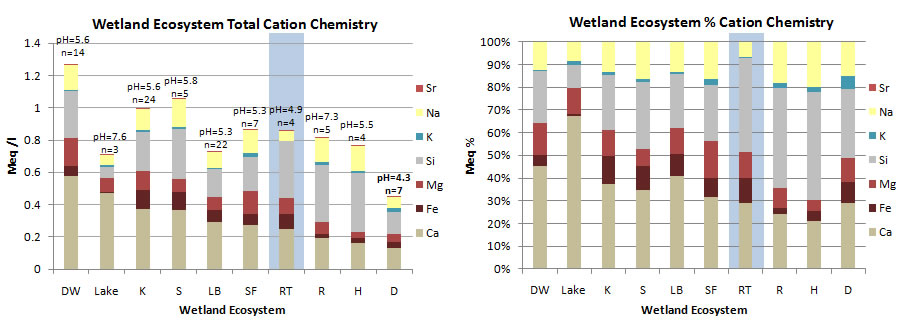
Cation chemistry by Geomorphic Component. VLD Trough wetlands (highlighted in blue) have moderately high cation concentrations compared to other Geomorphic Components. This indicates a strong groundwater discharge influence on porewater chemistry. Concentrations and pH would probably be higher if more eastern, non-bog samples were included. Although calcium and silicon show the greatest concentrations, magnesium and iron concentrations in our area are high for natural waters. DW = Drainageway, K = Kettle; S = Discharge Slope; LB = Lakebed; SF = Spring Fen; RT = VLD Trough; R= Riparian; H = Headwater Fen; D = Depression.
Samples were collected from a surface pool where possible, otherwise from a separate shallow pit excavated to just below the water table. All samples were filtered through either a 0.2 micron filter using a disposable syringe, or pumped through a 0.45 micron filter using a peristaltic pump. Samples were acidified with ultra-pure nitric acid and kept cool until analysis on a direct current plasma spectrometer to about 5% accuracy (except K, 10-20% accuracy).
VLD Trough Wetland Hydrologic Components:
Map unit names are made of combinations of map components. A suffix ‘c’ indicates a created wetland, and a ‘d’ indicates a highly disturbed wetland.
- RT1: Ponds in Troughs.
- RT2: Trough peatlands with water table near the surface most of the growing season. Often dominated by sedges and/or buckbean.
- RT3: Troughs with deeper water table, often dominated by shrubs especially sweetgale and dwarf birch.
- RT4: Forested Troughs, deeper, seasonally fluctuating water table, some are bogs.
| Table 3.Summary of VLD Trough Map Unit occurrence. VLD Trough wetlands are only mapped in the Mat-Su Valley. | ||||
| Map Unit | N | Hectares | % Polygons | % Area |
| RT1 | 14 | 57 | 0.06 | 0.03 |
| RT12 | 4 | 12 | 0.02 | 0.01 |
| RT1-3 | 5 | 56 | 0.02 | 0.03 |
| RT1-4 | 1 | 11 | 0.00 | 0.01 |
| RT1d | 1 | 15 | 0.00 | 0.01 |
| RT2 | 29 | 98 | 0.12 | 0.05 |
| RT21 | 7 | 54 | 0.03 | 0.03 |
| RT23 | 23 | 139 | 0.10 | 0.07 |
| RT23d | 1 | 9.9 | 0.00 | 0.01 |
| RT24 | 1 | 3.2 | 0.00 | 0.00 |
| RT2-4 | 8 | 49 | 0.03 | 0.03 |
| RT3 | 41 | 125 | 0.17 | 0.07 |
| RT32 | 16 | 180 | 0.07 | 0.10 |
| RT32d | 1 | 14 | 0.00 | 0.01 |
| RT34 | 27 | 170 | 0.11 | 0.09 |
| RT3d | 5 | 4.1 | 0.02 | 0.00 |
| RT4 | 66 | 262 | 0.27 | 0.14 |
| RT42 | 2 | 16 | 0.01 | 0.01 |
| RT43 | 41 | 320 | 0.17 | 0.17 |
| RT43d | 1 | 0.1 | 0.00 | 0.00 |
| RT4d | 3 | 3.6 | 0.01 | 0.00 |
| RTd | 1 | 1.1 | 0.00 | 0.00 |
